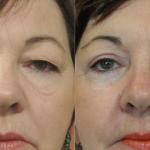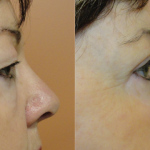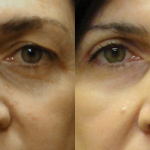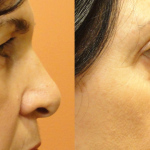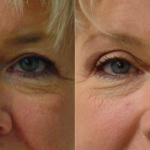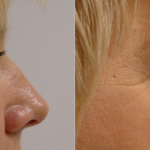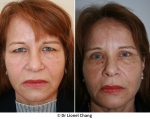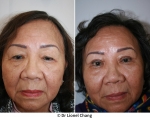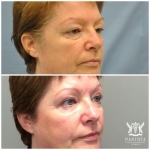Eyelid surgery or Blepharoplasty – the medical term for this procedure – is an operation to remove excess skin around the eye area. Excess skin and bags can not only make you look tired and drained but can also make you look much older then you are – or want to look.
Why have Eyelid Surgery?
Eyelid surgery or Blepharoplasty is a specialized surgery, which can help take years off your face. Some people notice over time, that their skin has become saggy with large ‘hoods’ found above their eyes. In addition they may also notice strange pockets of fat stored under the eyes. It is at this stage that individuals then seek the advice of a plastic surgeon.
Blepharoplasty does not only refer to the eyelids, but includes the area around the eyes as well. This procedure helps to remove the excess sagging skin from around the eyes as well as the fatty tissue. This surgery can also be used to smooth out fine lines and wrinkles which are often known as ‘Crows Feet’ which can be found in the corners of the eyes.
There are many benefits to having eyelid surgery. Having a small procedure like this can boost an individual’s confidence and helps to increase their self esteem. This procedure can also help the individual to apply make up in a quick and efficient fashion as well as improve the overall look and ‘freshness’ of the face.
When considering having eyelid surgery, your plastic surgeon will go through the two areas – upper and lower eyelids. The surgeon will then help you to make the decision to have either one of the two surgeries or both at the same time.
Upper eyelid surgery for some can be extremely simple and can consist of just a local anaesthetic and a light sedation. The surgeon will use a light sedation as this means that the recovery time for the procedure will be much quicker than that of a general anaesthetic.
The eyelid surgery begins with a small incision that will be made along the crease of the upper eyelid. As this is a natural crease, it will be invisible to others and just seem like the natural line you have there already.
The next step of this procedure is similar to facelift surgery, where by the surgeon will peel the skin away from the underlying tissue and will then remove any excess fat, tighten up the muscle, then remove any excess skin and seal up the area. Usually, just before the surgeon seals up the area, the skin will be stretched over the area, smoothing out all fine lines and wrinkles.
The surgeon can use two kinds of techniques to seal up the wound. The first technique would be the usual stitches that will be soluble meaning that they will not have to be removed from the area; the other technique is gluing the wound with surgical glue. Surgical glue is an adhesive, which can be used on skin to hold it together before the natural healing process takes over.
The lower eyelid surgery is almost always completed under general anaesthetic. The surgeon will make a simple incision along the lower lash line and remove any excess fatty tissue from underneath the eye, which is commonly known as ‘bags’. The surgeon will then stretch the skin out to remove the lines and wrinkles and the wound will be stitched up.
Risks and Complications
Generally, modern day surgery is considered safe.
There are no procedures which are completely risk free. Complications are rare, however anyone who is thinking about having this surgery must be aware of the risks and complications which may arise.
Undergoing a general anaesthetic can have many risks, which include; slowed heart rate and blood pressure, blood clot in the lungs, blood clot in the legs, heart failure and even death.
Approximately one-third of patients who receive an anaesthetic during surgery will experience “anaesthesia sickness” or post-operative nausea and vomiting (POVN).
The complications that can arise with the procedure itself include:
Possible blurred vision is a complication however this is usually temporary, difficulty moving in opening and closing the eyes, scarring, red eyes, infection, bleeding, dry eyes and asymmetry when healing. Swelling and bruising of the eyelids can also happen as they have been damaged. Occasionally this swelling is due to an infection, which could result in the individual having to go on a short course of antibiotics. If the infection becomes worse and an abscess forms on the eyelid, then you must seek out professional help to either have the abscess removed surgically.
Q. How long will I have to take off work if I am having eyelid surgery?
A. You will only have to take off a matter of days and can get back to normal relatively quickly. Some choose to go back to work a day or so after having the operation and wear dark glasses so no one can see what they have had done. With some individuals, your eyes may appear as if you have been punched as they will be swollen and bruised, so it is suggested to take it easy for at least a few days and avoid strenuous exercise for at least a week.
Q. Is eyelid surgery safe?
A. Yes, eyelid surgery is safe. There have only been minimal reports on cases that have not had a positive outcome.
What does Blepharoplasty cost? What does eyelid surgery cost?
Blepharoplasty refers to eyelid surgery in general, but there are two different procedures – Upper Eyelid Surgery or Lower Eyelid Surgery. You can have one of these procedures done on its own, or you can have them both performed at the same time. Each surgery takes approximately the same time and costs about the same too. Most of the surgeries/clinics we spoke to just added up both of the costs for each of the surgeries if you wanted both done, but some gave a slightly reduced figure if you had both done at the same time.
Upper or Lower (done on its own without the other)
Approximately $1,800 – $5,000
Upper And Lower (performed at the same time)
Approximately $5,000 – $11,000

